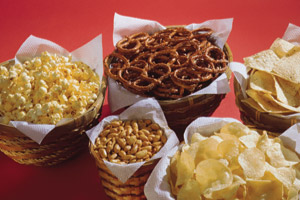 Perhaps you prefer classic potato chips or traditional tortilla chips. Maybe you like trying jazzy, new flavors and experiencing new snack concepts. As you enjoy the crunch of your favorite snack, do you ever wonder how the product came to be?
Perhaps you prefer classic potato chips or traditional tortilla chips. Maybe you like trying jazzy, new flavors and experiencing new snack concepts. As you enjoy the crunch of your favorite snack, do you ever wonder how the product came to be?Potato chips, tortilla chips, popcorn, nuts and crackers are all popular snacks that have withstood the test of time are technically termed first-generation snacks. Corn puffs, balls and rings are second-generation of snacks and made using extrusion technology.
I have found that extrusion technology offers an efficient, innovative way to mix, cook and form snacks with a specified texture and design that appeals to consumers. In short, a bin holding the ingredient blend feeds into an extruder barrel containing a screw that turns and pushes material toward a die end. A 15-20% dough moisture and mechanical energy provided by the kneading screw elements and steam locks build barrel pressure to cook starch. Thoroughly cooking starch permits structural modification necessary for good expansion and thin product cell walls that help provide the characteristics of a light texture.
Upon exiting the die opening, the product rapidly expands due to moisture evaporation with a pressure drop. This creates the desirable, light, airy texture found with snacks like Cheetos. A rotating knife cuts the product stream into individual pieces. Drying the pieces to a stable moisture content (about 2-5%) usually follows. The product can be baked or fried before it’s flavored with oil and a seasoning blend.
Third-generation snacks are the result of using specific sections of the extruder barrel for different functions. In the cooking zone, thermal and mechanical energy completely cook the starch. A vent in the cooling zone removes heat, pressure and air to cool the dough mass to 70-95 deg. C and prevents expansion. A forming zone compacts the dough before it exits through the die. This processing approach produces intricate shapes with no distortion. The dense, translucent product, referred to as a “half product,” is dried to 9-11% moisture for one to three hours at a high relative humidity to ensure equal moisture equilibration.
After bulk distribution to regional processors, frying expands the hard half products. Popping the pellets with hot air, infrared heating or microwaving is a popular alternative for calorie reduction. After the surface moisture is readily lost, heat penetrates each piece and the texture softens as internal pressure builds. At the critical temperature, moisture flashes off and rapid expansion occurs, creating a puffed product. The popped pieces are then flavored and packaged.
Further innovations include extruding two sheets of dough and embossing them with a pattern. The sheets are then brought together through a rotary die cutter. During cutting, the moisture level of each layer must be enough to seal the edges, while not allowing the center to stick together. With heating, the moisture evaporates and the flat, sealed air pocket expands to form a hollow pillow iconic to Doritos 3D’s.
Joining the product streams of two extruders or an extruder and pump through coextrusion can be used to create layers with different colors and textures. A filling can also be inserted to provide further uniqueness. One example is Combos coextruded, cheese-filled pretzels.
Third-generation snack formulations vary greatly depending on their targeted final product attributes. Whole grains are used in some crunchy hard snacks. Since the functional starch content is diluted by disruptive fiber and protein components of whole grains, less expansion will develop. Notably, the whole-grain constituents add health benefits to an energy-rich, fried snack. (For more details, read our plant story this month, starting on p. 28.)
The versatility of third-generation snacks has an inherent marketability and appeals to producers and consumers alike. Of course, the good ole’ first-generation snacks have as much appeal as ever and dominate the snack market. I suppose what you like is up to you or your tastebuds.
Elyse Buckley is a Master of Science candidate student in the grain science department at Kansas State University, Manhattan, Kan. She studied abroad last year and had an internship with Flowers Foods in 2009, spending time on a production line and in research and development. She will continue with her bakery studies and offer her observations and impressions of an education in baking.





